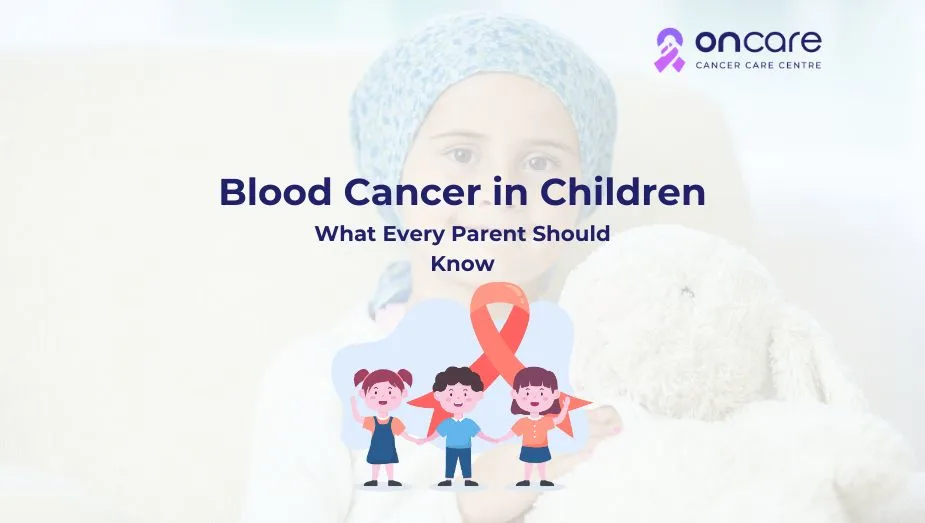Table of Contents
Blood Cancer in Children: What Every Parent Should Know

When a child is getting diagnosed with a blood cancer, it would turn upside down any family dynamics! Blood cancer in children is a serious health condition. With the right guidance and knowledge and with the help of early detection and effective cancer treatments, currently the treatment outcomes and survival rates are increasing!
In this article, we’ll discover more about the types of leukemia in children and symptoms of blood cancer in children, diagnosis, and treatments!
What is blood cancer in children?
Blood cancer is a serious health condition, also commonly known as hematologic cancer. It affects the blood, bone marrow and lymphatic system in the body.
The most common types of leukemia in children, including:
- Leukemia: Leukemia is a type of cancer that begins in the bone marrow and leads to the overproduction of white blood cells.
- Lymphoma: Lymphoma is a type of blood cancer, and it affects the lymphatic system. There are two main types of lymphoma, including Hodgkin and non-Hodgkin lymphoma.
- Myeloma: Myeloma, also commonly called Multiple myeloma, is a type of blood cancer developed in the plasma cells of the bone marrow. However, this is rare in children.
Types of childhood leukemia
Studies suggest that about all cases of childhood leukemia are acute, which means that it can develop rapidly. However, a small percentage of cases are chronic types of leukemia and it often develops slowly.
Here are some of the types of childhood leukemia, include:
- Acute Lymphoblastic Leukemia: This is the most common type of leukemia found in children.
- Acute Myeloid Leukemia: This is the second most common type of leukemia found in children.
- Chronic Myeloid Leukemia: This is a common type of leukemia found in adults and rare in children, accounts for approximately 2 to 3% of cases in children.
- Chronic Lymphocytic Leukemia : This is the most common type of leukemia found in adults but rarely in children.
Symptoms of blood cancer in children
Studies suggest that many signs and symptoms of blood cancer can often happen when leukemia starts to grow uncontrollably and crowd out healthy, normal cells in the body.
Recognising the signs early can significantly improve the treatment outcomes in many children. Early diagnosis can lead to more successful treatment outcomes in patients.
Common symptoms include:
- Fatigue
- Pale skin
- Infections
- Fever
- Extreme fatigue or weakness
- Experiencing shortness of breath
- Cough
Other common symptoms include:
- Bone or joint pain
- Loss of appetite
- Weight loss
- Headaches,
- Balance problems
- Vomiting
- Rashes
- Gum problems
Some of these symptoms are unspecific and common to any less serious medical conditions. If you are observing any of these symptoms in your children for more than 2 weeks, then book an appointment and consult a doctor.
What causes leukemia in children?
Leukemia develops in children when there is a change happening in the genetic material (DNA) in bone marrow cells. However, the exact cause of these genetic changes is not clear yet. Studies suggest that there are several factors that influence the risk of leukemia in children.
Risk factors affecting children
Studies suggest that leukemia is more common in boys than in girls. However, the exact reason is not clear yet.
The factors influence the cause of leukemia in children, including:
- Genetic syndromes or disorders
- Inherited immune system disorders
- Having a brother or sister with leukemia
Lifestyle-related risk factors:
- Smoking
- Excessive body weight
- Excessive alcohol consumption
- Exposed to sun
Environmental risk factors:
- Radiation exposure
- Exposure to chemotherapy
- Immune system suppression
How is childhood leukemia diagnosed?
The oncologists might use some diagnostic tests to confirm the leukemia in suspected patients.
Including:
- A physical examination
- Complete Blood Count Tests (CBC)
- Bone marrow tests
- Genetic testing
Once the oncologists confirm the leukemia in children, the healthcare provider suggests other tests to identify the spread of cancer in the patients.
Including:
- Imaging tests
- Lumbar puncture
What are the treatment options?
The treatment for leukemia mainly depends on the type and its severity in the child, their age, and other factors, including individual health conditions.
Here are some possible treatments including:
- Chemotherapy
- Radiation therapy
- Chemotherapy with stem cell transplant
- Targeted therapy
Many studies suggest that the treatments of childhood leukemia are successful. But these treatments can cause health complications or side effects after the treatments. Sometimes these side effects can appear later in life.
Children who already received leukemia treatments in their childhood needed regular follow-up visits and checkups. This helps to avoid any future complications.
Consult Today
Blood cancer in children is a life-changing and spine-chilling moment in every parent's life. With early detection, advanced treatment options, and strong emotional support, the majority of children can lead fulfilling and healthy lives. Awareness is the first step toward taking necessary actions. It's important for every parent to know more about the signs, notice the small changes in their children’s bodies, and take essential steps without wasting any more time!
At Oncare, we offer high-quality cancer treatments, including cancer surgeries, at affordable price packages, along with consultations from experienced cancer specialists!
If you or any loved ones of yours are diagnosed with cancer, then visit Oncare Cancer Center and book an appointment with our cancer specialists today! Get an estimated cost of your cancer treatments today!
Frequently Asked Questions
Most childhood leukemia are acute, including:
- Acute lymphocyte leukemia
- Acute myeloid leukemia
Leukemia happens in children when there are changes happening in the genetic material (DNA) in bone marrow cells. One of the real causes of these genetic changes is not clear yet. However, there are some factors that increase the risk of leukemia in children.
There are some factors that influence the risk of developing childhood leukemia, including:
- Having a brother or sister, especially a twin, with leukemia
- Treatment history of chemotherapy
- Exposure to radiation or past radiation therapy
- Having different types of genetic conditions
Here are some of the symptoms of leukemia, including:
- Feeling tired
- Fever or night sweats
- Easy bruising or bleeding
- Weight loss
- Loss of appetite
- Petechiae

